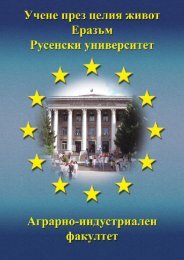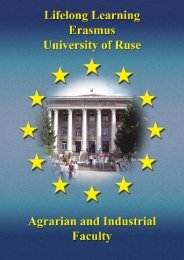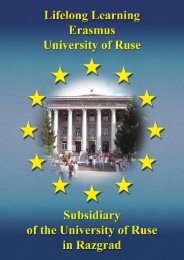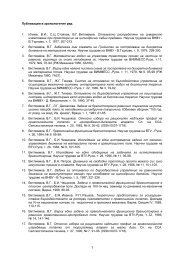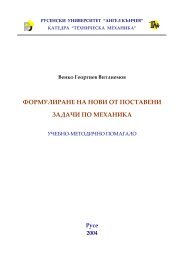Erasmus ECTS Information Package
Erasmus ECTS Information Package
Erasmus ECTS Information Package
You also want an ePaper? Increase the reach of your titles
YUMPU automatically turns print PDFs into web optimized ePapers that Google loves.
<strong>Erasmus</strong> <strong>ECTS</strong> <strong>Information</strong> <strong>Package</strong><br />
Faculty of EEEA<br />
3092 Single-chip Microcontrollers<br />
<strong>ECTS</strong> credits: 5<br />
Weekly classes: 2lec+0sem+0labs+2ps+2cw<br />
Assessment: continuous assessment<br />
Type of exam: written and oral<br />
Department involved:<br />
Department of Computing<br />
Faculty of Electrical Engineering, Electronics and Automation<br />
Lecturers:<br />
Prof. Angel Sotirov Smrikarov, MEng, PhD, Dept. of Computing, tel.: 888 743, 888 249,<br />
E-mail: ASmrikarov@ecs.uni-ruse.bg<br />
Abstract:<br />
The Single-chip Microcontrollers course aims to familiarize students with the contents of the most widespread<br />
families of CISC single-chip microcontrollers (SCM) and with the structure of their main representatives as well as<br />
with their CAD systems.<br />
The course has input-output links with the courses Computer organization, Microprocessors and Specialized<br />
Microprocessor Systems.<br />
Course content:<br />
Families CISC SCM. SCM with von Neumann architecture – structure, memory organization, addressing modes<br />
and instruction set, parallel and serial ports, timers/counters, A/D converters, impulse modulators, interrupt<br />
system. Programming languages. Development systems.<br />
SCM with Harvard architecture – structure, memory organization, addressing modes and instruction set, parallel<br />
and serial ports, timers/counters, A/D converters, impulse modulators, interrupt system. Programming languages.<br />
Development systems.<br />
Teaching and assessment:<br />
At the lectures students are familiarized in detail with the structure of main representatives of widespread SCM<br />
families. At the practice sessions students develop and test programs for these SCM. The subject of the course<br />
work is to design a microprocessor system based on a SCM and to develop a software library for it. At the exam<br />
the course work is defended and additional questions are asked, if necessary.<br />
3093 Integrated Environments<br />
<strong>ECTS</strong> credits: 5<br />
Weekly classes: 2lec+0sem+0labs+2ps+1ca<br />
Assessment: exam<br />
Type of exam: test<br />
Department involved:<br />
Department of Computing<br />
Faculty of Electrical Engineering, Electronics and Automation<br />
Lecturers:<br />
Assoc. Prof. Irina Ilieva Zheliazkova, MEng, PhD, Dept. of Computing, tel.: 888 744,<br />
E-mail: Irina@ecs.uni-ruse.bg<br />
Abstract:<br />
The course objective is to familiarise the students with the object modeling language, the common philosophy of<br />
the integrated environments for rapid development of WINDOWS applications, the features of the library, objectoriented,<br />
and visual programming in VISUAL C++ and DELPHI.<br />
Course prerequisites include: Software Engineering, System Programming, and Data bases; co-requisites include<br />
<strong>Information</strong> systems, Multimedia Systems and Technologies, Language Processors and it is linked with the thesis<br />
project.<br />
Course content:<br />
Diagrams for object modeling of software tools. Philosophy of the integrated environments for rapid development<br />
of WINDOWS-based applications. The features of the library, object-oriented, and visual programming in VISUAL<br />
C++ and DELPHI.<br />
Teaching and assessment:<br />
The lectures give the basic knowledge, and exercises enable the students to apply it in practice. There are 2 hours<br />
of lectures and 2 hours of exercises every week. The teams of two students design, implement, and test one<br />
project for 6 exercises in each environment. The results from each exercise for each student are assessed by the<br />
assistant. The final mark is formed as an average of the marks for the practical exercises, course task and a test<br />
on the lecture material.<br />
171



